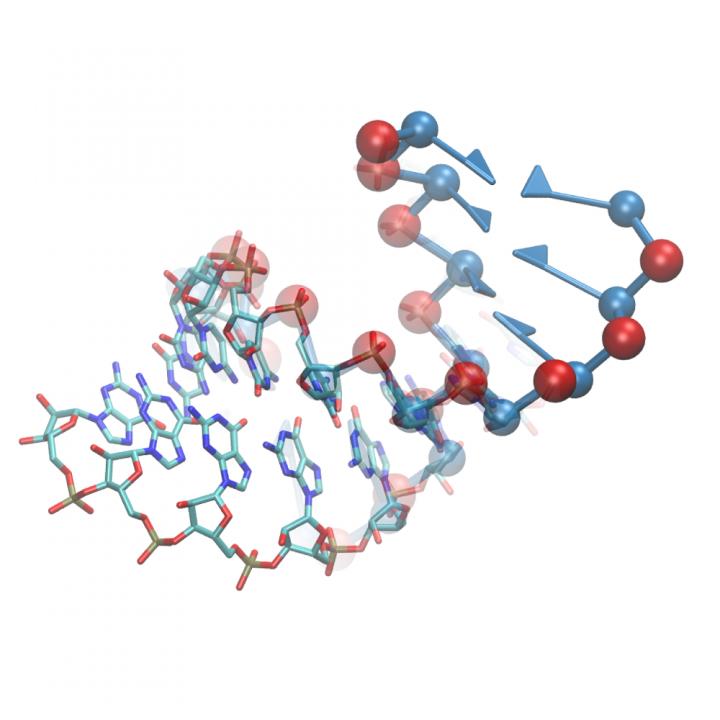Discovering the structure of RNA

A new study develops an innovative simulation model able to efficiently predict the conformation of ribonucleic acid molecules, opening up interesting opportunities for application and research Credit: Simon Poblete
It is the less known member of the nucleic acid family, superseded in popularity by its cousin DNA. And yet RNA, or ribonucleic acid, plays an essential role in many biological processes: not only as messenger molecule with the task of transmitting genetic information from the nucleus to the cytoplasm for protein production, but also as protagonist of different and significantly important cellular mechanisms.
In many of these, its structure plays a crucial role. Structure is different and characteristic for each RNA depending on the sequence of specific units, known as nucleotides, which compose it like the links of a chain.
A research team at SISSA, led by Professor Giovanni Bussi, has developed a computerised simulation model which can effectively predict the three-dimensional conformation of the RNA filament starting from a sequence of nucleotides. The lead author of the study, just published in the journal Nucleic Acids Research, is SISSA researcher Simón Poblete. The work promises to have a significant impact in the research and application field.
«RNA structure is a crucial factor for many of its functions», explains Giovanni Bussi. «The experimental determination of RNA structures may take years, which is why there is great interest in developing methods to predict its structure. Until today, predictive models have concentrated primarily on the study of RNA parts which form double helices.
However, the RNA filament can take specific and complex conformations governed by the so-called “non-canonical” interactions, which are very different from those predicted by Watson-Crick's double helix model for DNA».
Current simulation models, says Bussi, «work very well: starting from one sequence they are able to envisage a variety of possible structures. The problem is that they are unable to tell which is the right structure among many. Our model, which uses a simplified representation of RNA and has been designed explicitly to correctly predict non-canonical interactions, has proven very efficient in this regard».
To test its quality, researchers have used it to predict the structure of RNA molecules whose three-dimensional conformation is known, starting from the knowledge of the sequence alone. «Comparing our predictions with known structures, we have understood that our approach really works» confirms Giovanni Bussi.
This can have an important impact on basic research, to help shed light on the relationship between structure and function of these molecules, but also on application realms, above all in the medical and therapeutic sector.
Bussi adds: «RNA is particularly interesting for its practical implications; once a RNA molecule has been identified, as many molecules as desired can be obtained with little effort and identical to the first one by means of a fast and low-cost replication process. If, for example, we were able to find the RNA molecule able to trigger precise processes within the organism with important therapeutic effects due to its specific structure, this would open up truly unheard-of prospects».
Media Contact
All latest news from the category: Life Sciences and Chemistry
Articles and reports from the Life Sciences and chemistry area deal with applied and basic research into modern biology, chemistry and human medicine.
Valuable information can be found on a range of life sciences fields including bacteriology, biochemistry, bionics, bioinformatics, biophysics, biotechnology, genetics, geobotany, human biology, marine biology, microbiology, molecular biology, cellular biology, zoology, bioinorganic chemistry, microchemistry and environmental chemistry.
Newest articles

First-of-its-kind study uses remote sensing to monitor plastic debris in rivers and lakes
Remote sensing creates a cost-effective solution to monitoring plastic pollution. A first-of-its-kind study from researchers at the University of Minnesota Twin Cities shows how remote sensing can help monitor and…

Laser-based artificial neuron mimics nerve cell functions at lightning speed
With a processing speed a billion times faster than nature, chip-based laser neuron could help advance AI tasks such as pattern recognition and sequence prediction. Researchers have developed a laser-based…

Optimising the processing of plastic waste
Just one look in the yellow bin reveals a colourful jumble of different types of plastic. However, the purer and more uniform plastic waste is, the easier it is to…



